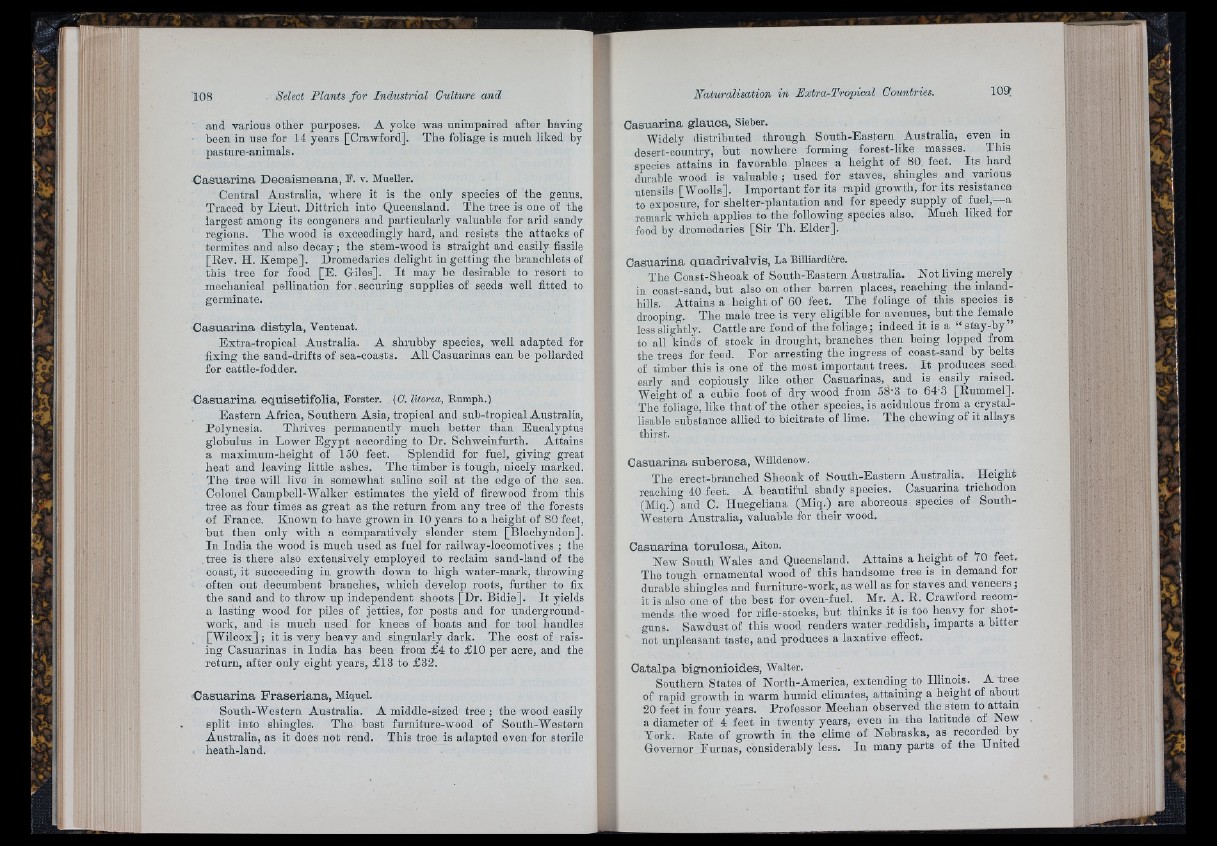
and various other purposes. A yoke was unimpaired after having
been in use for 14 years [Crawford]. The foliage is much liked by
pasture-animals.
C a s u a r in a D e o a is n e a n a , E. v. Mueller.
Central Australia, where it is the only species of the genus.
Traced by Lieut. Dittrich into Queensland. The tree is one of the
largest among its congeners and particularly valuable for arid sandy
regions. The wood is exceedingly hard, and resists the attacks of
termites and also decay; the stem-wood is straight and easily fissile
[Eev. H. Kempe]. Dromedaries delight in getting the branchlets of
this tree for food [E . Giles]. I t may be desirable to resort to
mechanical pollination for securing supplies of seeds well fitted to
germinate.
C a s u a r in a d i s ty la , Ventenat.
Extra-tropical Australia. A shrubby species, well adapted for
fixing the sand-drifts of sea-coasts. All Casuarinas can be pollarded
for cattle-fodder.
C a s u a r in a e q u is e tif o lia , Forster. (G. lUorea, Rumph.)
Eastern Africa, Southern Asia, tropical and sub-tropioal Australia,
Polynesia. Thrives permanently much better than Eucalyptus
globulus in Lower Eg y p t according to Dr. Schweinfurth. Attains
a maximnm-height of loO feet. Splendid for fuel, giving great
heat and leaving little ashes. The timber is tough, nicely marked.
The tree will live in somewhat saline soil a t the edge of the sea.
Colonel Campbell-Walker estimates the yield of firewood from this
tree as four times as great as the return from any tree of the forests
of France. Known to have grown in 10 years to a height of 80 feet,
hut then only with a comparatively slender stem [Blechyndon].
In India the wood is much used as fuel for railway-locomotives ; the
. tree is there also extensively employed to reclaim sand-land of the
coast, it succeeding in growth down to high water-mark, throwing
often out decumbent branches, which develop roots, further to fix
the sand and to throw up independent shoots [Dr. Bidie]. I t yields
a lasting wood for piles of jetties, for posts aud for undergroundwork,
and is much used for knees of boats and for tool handles
[Wilcox] ; it is very heavy and singularly dark. The cost of raising
Casuarinas in India has been from £4 to £10 per acre, aud the
return, after only eight years, £13 to £32.
C a s u a r in a F r a s e r i a n a , Miquel.
South-Western Australia. A middle-sized tree ; the wood easily
split into shingles. The best furniture-wood of South-Western
Australia, as it does not rend. This tree is adapted even for sterile
heath-land.
C a s u a r in a g la u c a , Sieber.
Widely distributed through South-Eastern Australia, even in
desert-country, but nowhere forming forest-like masses. This
species attains in favorable places a height of 80. feet. Its hard
durable wood is valuable ; used for staves, shingles and various
utensils [Woolls]. Important for its rapid growth, for its resistance
to exposure, for shelter-plantation and for speedy supply of fuel, a
remark which applies to the following species also. Much liked for
food by dromedaries [Sir Th. Elder].
C a s u a r in a q u a d r iv a lv i s , La Billiardiére.
The Coast-Sheoak of South-Eastern Australia. Not living merely
in coast-sand, but also on other barren places, reaching the inlaud-
hills. Attains a height of 60 feet. The foliage of this species is
drooping. The male tree is very eligible for avenues, but the female
less slightly. Cattle are fond of the foliage; indeed it is a “ stay-by ”
to all kinds of stock in drought, branches then being lopped from
the trees for feed. For arresting the ingress of coast-sand by belts
of timber this is one of the most important trees. I t produces seed
early and copiously like other Casuarinas, and is easily raised.
Weight of a cubic foot of dry wood from 58'3 to 64'3 [Rummel].
The foliage, like th a t of the other species, is acidulous from a crystallisable
substance allied to hicitrate of lime. The chewing of it allays
thirst.
C a s u a r in a s u b e r o s a , Willdenow.
The erect-branched Sheoak of South-Eastern Australia. Height
reaching 40 feet. A beautiful shady species. Casuarina trichodon
(Miq.) and C. Huegeliana (Miq.) are aboreous species of South-
Western Australia, valuable for their wood.
C a s u a r in a to r u lo s a , Aiton.
New South Wales and Queensland. Attains a height of 70 feet.
The tough ornamental wood of this handsome tree is in demand for
durable shingles and furniture-work, as well as for staves and veneers ;
it is also one of the best for oven-fuel. Mr. A. B. Crawford recommends
the ivood for riile-stocks, but thinks it is too heavy for shotguns.
Sawdust of this wood renders water reddish, imparts a bitter
not unpleasant taste, and produces a laxative effect.
C a ta lp a b ig n o n io id e s , Walter.
Southern States of North-America, extending to Illinois. A tree
of rapid growth in warm humid climates, attaining a height of about
20 feet in four years. Professor Meehan observed the stem to attain
a diameter of 4 feet in twenty years, even in the latitude of New
York. Bate of growth in the clime of Nebraska, as recorded_ by
Governor Furnas, considerably less. In many parts of the United